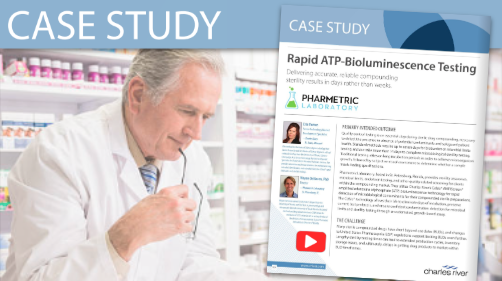Rapid ATP-Bioluminescence Testing
Delivering accurate, reliable compounding sterility results in days rather than weeks.
PRIMARY INTENDED OUTCOME
Quality control testing is an essential step during sterile drug compounding, necessary to detect the presence or absence of potential contaminants and safeguard patient health. Standard methods require up to seven days for bioburden or microbial limits testing and can take more than 14 days to complete microbiological sterility testing. Traditional testing relies on long incubation periods in order to achieve microorganism growth, followed by subjective visual assessment to determine whether a sample meets testing specifications.
Pharmetric Laboratory, based in St. Petersburg, Florida, provides sterility assurance, microbial limits, endotoxin testing, and other quality-related screening for clients within the compounding market. They utilize Charles River’s Celsis® AMPiScreen® amplified adenosine triphosphate (ATP) bioluminescence technology for rapid detection of microbiological contaminants for their compounded sterile preparations. The Celsis® technology allows their lab to eliminate days of incubation, preserve current test protocols, and ensure confident contamination detection for microbial limits and sterility testing through an automated, growth-based assay.
THE CHALLENGE
Many sterile compounded drugs have short beyond-use dates (BUDs), and changes to United States Pharmacopeia (USP) regulations support limiting BUDs even further. Lengthy sterility testing times can lead to extended production cycles, inventory storage issues, and, ultimately, delays in getting drug products to market within BUD timeframes.
Sample attributes pose an additional challenge to traditional test methods. Sterile compounded pharmaceutical products come in many forms; some are thin, colorless solutions, while others may be oils, gels, ointments, or even pellets. Test-sample characteristics such as cloudiness or viscosity can create hurdles during the testing process. Growth-based sterility tests rely on the ability of the lab analyst to make a subjective assessment about whether turbidity from microbial growth is present; understandably, the characteristics of certain drug products can make this assessment difficult.
“Products which create turbidity when added to a growth medium lead to increased incubation time and accurate visual reading of traditional results can be difficult,” said Wayne DeHaven, PhD, Director of Pharmetric Laboratory.
THE DECISION
Charles River provides innovative technology that supports consistency and control in drug manufacturing, monitoring, and testing in order to help reduce associated risks. Their Celsis® AMPiScreen® technology detects contaminants in a drug sample through the luciferin-luciferase reaction, which manifests as a chemical conversion of organism-based energy into visible light. Ordinarily, ATP is present in all living cells, and so it makes an excellent marker for quicker detection of microbiological contamination. The Celsis® ATP-based technology can significantly reduce the usual sterility test incubation period.
For Pharmetric Laboratory, the choice to offer Celsis® rapid microbial detection through AMPiScreen® technology to their sterile compounding clients was a practical one. “In a nutshell, this approach is a lot less problematic than standard compendial testing,” said DeHaven. The inherent subjectivity of visual growth confirmation is removed and replaced with a confident yes or no answer, providing the same result as the compendial sterility test and critical information about whether to release or hold a product.
Utilizing Celsis® rapid microbial detection systems and AMPiScreen® technology can rapidly detect the presence of ultra-low levels of microbiological contamination up to 50% faster than the traditional sterility test. This ultimately reduces testing time and preserves accuracy, allowing compounders to comply with BUD regulations and protect patient safety, while also improving revenue streams. “This is a critical piece for compounders,” said DeHaven. “If a compounded product spends half of its BUD in quarantine waiting for sterility testing, you could be squeezed out of business. The amount of time required for standard compendial testing of a compounded product almost makes no sense compared to ATP testing.”
THE RESULTS
The use of rapid microbial detection systems and ATP-bioluminescence technology is well characterized in other industries, and it has been adapted for drug sterility testing more recently. Charles River’s ATP-bioluminescence test may be used in line with USP regulations regarding sterility-testing sample preparation and growth, and the process is largely similar to standard testing.
The differences between compendial testing and combined Celsis® rapid microbial detection systems and AMPiScreen® amplified ATP-bioluminescence technology lie in the method of contaminant detection and the amount of time required for incubation. “ATP-bioluminescence testing really is the perfect application for sterile drug compounding and accommodating BUDs,” said DeHaven.
Compared to standard testing, ATP-bioluminescence testing produces minimal artifacts that could lead to false-positive results. “The results of ATP-bioluminescence testing are purely objective, an indicator,” said Erin Patton, Technology Market and Development Manager at Charles River. “A numerical result shows simply and clearly that the product either meets or fails the test.” Compendial testing relies on a trained technician to provide a subjective reading of the media for colony growth and turbidity and is more prone to misinterpretation of results and error.
THE CONCLUSION
Utilizing the Celsis® rapid microbial detection systems and AMPiScreen® amplified ATP-bioluminescence technology allows Pharmetric to confirm their clients’ product sterility in a matter of days versus the weeks required for traditional methods. The test produces reliable, repeatable results that meet regulatory standards.
Client education about ATP-bioluminescence technology has expanded their customer base, and Pharmetric hopes to grow the market further. “When we started offering rapid ATP-bioluminescence testing, many clients did not fully understand the science behind it,” said James A. Brown, National Director of Sales for Pharmetric Laboratory. “Discussing method suitability woke up many people, and word is getting out that the ATP-bioluminescence test offers better science as well as faster results.”





